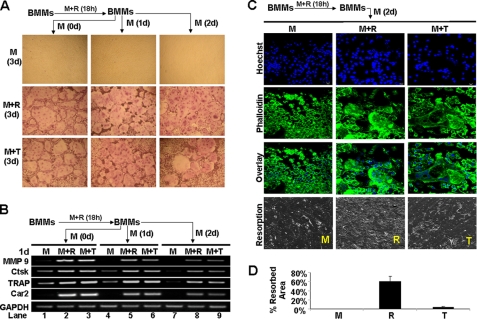FIGURE 4.
RANKL mediated-BMM priming is durable. A, BMMs were treated with M-CSF (M, 44 ng/ml) and RANKL (R, 100 ng/ml) for 18 h and then cultured with M-CSF alone for 0, 1, or 2 days (d) before treating with M-CSF (44 ng/ml) alone, M-CSF (44 ng/ml) and RANKL (100 ng/ml), or M-CSF (44 ng/ml) and TNF (T, 5 ng/ml) for 3 days. The cultures were stained for TRAP activity. B, BMMs were treated with M-CSF (44 ng/ml) and RANKL (100 ng/ml) for 18 h and then cultured with M-CSF alone for 0, 1 or 2 days before treating with M-CSF (44 ng/ml) alone, M-CSF (44 ng/ml) and RANKL (100 ng/ml), or M-CSF (44 ng/ml) and TNF (5 ng/ml) for 1 day. Gene expression was determined by semiquantitative RT-PCR. C, BMMs on bone slices were treated with M-CSF (44 ng/ml) and RANKL (100 ng/ml) for 18 h and then cultured with M-CSF alone for 2 days before treating with M-CSF (44 ng/ml) alone, M-CSF (44 ng/ml) and RANKL (100 ng/ml), or M-CSF (44 ng/ml) and TNF (5 ng/ml) for 3 days, and bone slices were then stained with Hoechst 33258 (Hoechst) or Alexa Fluor 488 phalloidin (Phalloidin). A separate set of cultures was continued for 4 additional days to perform bone resorption assays. D, quantification of the bone resorption assays is shown. Bars show averages ± S.D.

